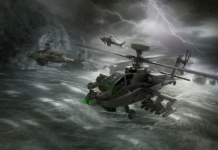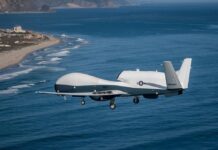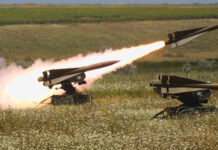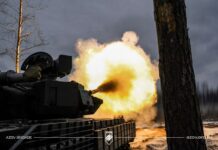The balance of armour in the Ukraine conflict appears to be shifting, as Russian losses mount and the transfers to Ukraine of main battle tanks (MBTs) and other weapons from its Western allies gather pace.
As of 9 February 2023, as the first anniversary of Russia’s 24 February 2022 invasion of Ukraine approached, the Oryx military website was listing Russian MBT losses at 1,688, of which 1,000 were destroyed, 79 were damaged, 65 were abandoned and 544 were captured.
Oryx only lists losses that have been verified by photo- or videographic evidence, so the losses are almost certainly higher. Most of the MBT losses are older types such as various models of the T-62, T-64, T-72 and T-80, but Oryx also lists 49 T-90A/S/Ms as having been lost, as well as the destruction of a BMPT Terminator tank support vehicle, which was destroyed on 9 February 2023. This AFV was only introduced into service with Russia in 2018.
In terms of other armour Oryx assesses Russia to have lost 2,022 infantry fighting vehicles (IFVs), 295 armoured personnel carriers (APCs), 333 self-propelled guns (SPGs), 172 multiple rocket launchers (MRLs, and 776 other AFVs as well as hundreds of other armoured vehicles.
Prior to Russia’s February 2022 invasion the Military Balance database published by the International Institute for Strategic Studies (IISS) in London assessed that Russia had around 3,330 operational tanks (2,840 with the ground forces, 330 with its naval infantry, and 160 with its airborne forces). It therefore now appears that Russia has lost almost half that number.
While Russian forces are unlikely to run out of tanks anytime soon – they have several thousand in storage – the refurbished tanks used to replenish Russian MBT formations in Ukraine may well prove to be less capable and less serviceable than the lost tanks they are replacing. Added to this, ESD estimates that a large percentage of Russian tanks in storage would need major work before they are ready for service. This would mean that the actual figure for tanks Russia could realistically restore to operational condition within a short time period is considerably lower than the boilerplate figure of thousands in storage.
Restoring many of the older tanks to operational service would also require a fairly high resource commitment from Russian industry, which is already struggling to meet what are probably unrealistic tank production targets dictated by Moscow, under state defence orders that produce a minimal profit margin. While T-90M and T-72B3/B3M MBTs are among types observed being transported to the Ukrainian front, a source inside Russian state-owned defence conglomerate Rostec told the exiled Russian newspaper Novaya Gazeta Europe in November 2022 that Russian tank manufacturer Uralvagonzavod (UVZ) might only be able to produce around 200 to 250 tanks per year.
Regarding two of Russia’s latest AFV designs, the T-14 Armata MBT and 2S35 Koalitsiya-SV self-propelled howitzer, the Rostec source told Novaya Gazeta Europe that Russian industry cannot provide the special metals required for their high-pressure gun barrels.
The overall picture presented to Novaya Gazeta Europe by its sources inside Russia was of a dysfunctional Russian armour production capability depleted by years of corruption, mismanagement and underfunding.
Meanwhile, the Ukrainian Army is, of course, also suffering losses to its armoured formations. As of 9 February, Oryx assesses that Ukraine has lost at least 459 tanks, 476 IFVs, 227 APCs, 110 SPGs, 38 MRLs, 264 other AFVs and hundreds of other armoured vehicle types.
However, Ukraine’s Western allies have now undertaken to supply significant amounts of AFVs to rebuild Ukraine’s armoured formations. Looking at MBTs specifically, Ukraine has been offered more than 640 tanks, according to Oryx, most of which consist of T-72 variants from former Eastern Bloc countries, along with some even older models, such as the M-55: a heavily upgraded variant of the T-55 family. In March 2022 Poland got the ball rolling by pledging more than 260 T-72s and then on 27 January 2023 pledged another 60 tanks, including 14 Leopard 2A4s and 30 PT-91s, with the remainder thought to be T-72s. From the start of 2023 West European countries and the United States also began to contribute: on 17 January the United Kingdom said it would send 14 Challenger 2s; on 25 January Germany pledged to supply 14 Leopard 2A6s and then Washington said it would send 31 M1 Abrams; on 26 January Canada said it would send four Leopard 2A4s; on 30 January Norway said it would send a portion of its 36 Leopard 2A4s; on 1 February Spain said it would send up to six Leopard 2A4s; and on 7 February Denmark, Germany and The Netherlands announced the joint delivery of at least 100 Leopard 1A5 MBTs.
The table below provides a summary of allied tank commitments to Ukraine:
| Donor | Tank family | Variant | Quantity |
| Canada | Leopard 2 | Leopard 2A4 | 4 |
| Czech Republic | T-72 | T-72M1 | 35+ |
| Czech Republic | T-72 | T-72EA | 90 |
| Denmark, Germany, Netherlands | Leopard 1 | Leopard 1A5 | 100+ |
| Germany | Leopard 2 | Leopard 2A6 | 14 |
| North Macedonia | T-72 | T-72A | 8+ |
| Poland | T-72 | T-72A/T-71M1 | 276+ |
| Poland | T-72 | PT-91 | 30 |
| Poland | Leopard 2 | Leopard 2A4 | 14 |
| Slovenia | T-55 | M-55S | 28 |
| Spain | Leopard 2 | Leopard 2A4 | 6 |
| UK | Challenger 2 | Challenger 2 TES (est) | 12 (est) |
| USA | M1 Abrams | M1A1/M1A2 (est) | 31 |
The numbers alone, of course, do not provide a clear picture of capability. For example, of the 640-plus tanks pledged or delivered to Ukraine so far, only 81 of them are from a present-generation Western tank family, while only around 14-45 (Leopard 2A6 and M1A2 if this variant is chosen) of these are likely to be in a relatively modern variant.
Moreover, the training, maintenance and logistics challenges of supporting such a diverse fleet of armour should not be underestimated; the rifled 120 mm guns of the Challenger 2s, for example, require ammunition unique to the type.
Despite these issues, the West’s commitment to bolstering Ukraine’s tank fleet is clear. However, it remains to be seen whether Kyiv can muster enough war materiel to proactively go on the offensive, rather than simply holding its ground against Russian attacks.
Peter Felstead












